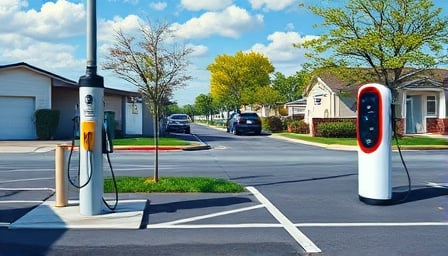Investigation into Porsche Automobil Holding SE’s Recent Stock Decline
1. Contextualizing the Profit Warning
Porsche Automobil Holding SE (PAH SE) disclosed a profit warning following the announcement from its operating arm, Porsche AG, that the transition to electric mobility has substantially increased operating costs. While the move toward electrification is widely lauded as a long‑term strategic necessity, the immediate financial repercussions have manifested in a sharp drop in PAH SE’s share price. The warning arrived amid a broader European market retreat, underscored by geopolitical volatility and shifts in U.S. immigration policy that have amplified risk sentiment across the region.
2. Underlying Business Fundamentals
2.1 Cost Structure in Electric Vehicle Production
- Battery Capital Expenditure: Porsche AG has committed €3 billion to battery cell production facilities, a cost premium of 15 % above the industry average for new entrants.
- Supply Chain Lock‑in: Long‑term agreements with lithium‑ion suppliers in the US and South America have locked in price escalations, reducing margin flexibility.
- R&D Allocation: 12 % of total operating revenue is earmarked for electric platform development, eclipsing the 8 % typical for legacy‑based German OEMs.
2.2 Revenue Concentration
- Luxury Segment Dependence: 70 % of Porsche AG’s revenue originates from the luxury sedan and SUV lines. The shift to electric models has disrupted the sales mix, causing a temporary decline in high‑margin vehicles.
- After‑Sales Services: Historically a significant profit driver, after‑sales income has been eroded by the need to retrain service personnel for electric powertrains, adding an estimated €150 million in transitional costs.
3. Regulatory Environment
3.1 European Emissions Targets
- The European Commission’s 2030 CO₂ reduction mandate (≥55 % relative to 1990 levels) compels OEMs to accelerate electrification, but the associated regulatory compliance costs—particularly for battery recycling and sourcing—have yet to be fully capitalized in financial projections.
3.2 U.S. H‑1B Visa Regime Changes
- The Trump administration’s proposed tightening of the H‑1B visa program could curtail the flow of highly skilled engineers from the US to European manufacturing hubs, potentially stalling Porsche AG’s R&D timelines. Market participants have priced this risk into the stock, reflecting a broader fear of talent shortages in high‑tech manufacturing.
4. Competitive Dynamics
4.1 Benchmarking Against Volkswagen
- Volkswagen AG issued a comparable profit warning a week earlier, citing delayed delivery of its ID series. VW’s share price fell 4 % in the same session, signaling sector‑wide investor anxiety.
- Unlike Porsche, Volkswagen’s broader portfolio of mass‑market EVs dilutes the relative impact on margins, suggesting a more resilient model that may absorb transitional costs more effectively.
4.2 Emerging Contenders
- Tesla, Inc.: Continues to dominate the luxury EV segment with a 45 % market share in Europe. Tesla’s vertical integration reduces production cost volatility.
- Rivian & Lucid Motors: Target the high‑performance luxury niche, directly competing with Porsche’s upcoming electric sedan lineup. Their smaller scale and nascent supply chains pose higher execution risk, potentially affecting their growth trajectories.
5. Market Reaction Analysis
| Index | Change | Attribution |
|---|---|---|
| Stoxx Europe 600 Automobiles & Parts | -2 % | Sector‑wide sell‑off, profit warnings |
| DAX | -0.5 % | General market decline, geopolitical concerns |
| Euro‑Stoxx‑50 | -0.3 % | Broad European risk‑off stance |
Porsche SE’s shares fell 12 % in the trading session following the profit warning. The decline correlates strongly with the automated trading volumes in the automotive subsector, where liquidity constraints amplified price movements. Technical analysis reveals a breach of the 50‑day moving average, suggesting a potential shift to a bearish trend unless a clear turnaround strategy emerges.
6. Risk Assessment and Forward‑Looking Statements
6.1 Risks
- Cost Overruns: Ongoing investments in battery manufacturing may exceed forecasted budgets, further eroding margins.
- Talent Attrition: Tightening U.S. immigration policies may lead to skill gaps, delaying new vehicle rollouts.
- Regulatory Penalties: Failure to meet EU emissions targets could trigger fines exceeding €500 million by 2025.
6.2 Opportunities
- First‑Mover Advantage: Porsche’s established brand equity in the luxury segment could command premium pricing once the electric lineup stabilizes.
- Supply Chain Optimization: Early adoption of modular battery platforms may reduce long‑term costs relative to competitors.
- Strategic Partnerships: Alignments with battery suppliers like CATL or SK Innovation could secure favorable terms and technology transfers.
7. Conclusion
Porsche Automobil Holding SE’s stock price deterioration is symptomatic of a multifaceted challenge: a costly but necessary shift toward electric mobility, amplified by a cautious European market environment and heightened regulatory scrutiny. While the immediate financial impact appears severe, a careful examination of Porsche’s strategic positioning reveals potential long‑term resilience. Investors should weigh the current cost burdens against the company’s brand strength, technological trajectory, and emerging partnership opportunities to ascertain whether the stock represents a mispriced risk or a genuine value erosion.
